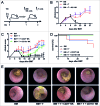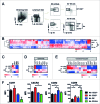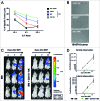Identification and characterization of the specific murine NK cell subset supporting graft- versus-leukemia- and reducing graft- versus-host-effects
- PMID: 25949862
- PMCID: PMC4368119
- DOI: 10.4161/2162402X.2014.981483
Identification and characterization of the specific murine NK cell subset supporting graft- versus-leukemia- and reducing graft- versus-host-effects
Abstract
Clinical studies investigating the impact of natural killer (NK) cells in allogeneic hematopoietic stem cell transplantation settings have yielded promising results. However, NK cells are a functionally and phenotypically heterogeneous population. Therefore, we addressed the functional relevance of specific NK cell subsets distinguished by expression of CD117, CD27 and CD11b surface markers in graft-versus-leukemia (GVL)-reaction and graft-versus-host-disease (GVHD). Our results clearly demonstrate that the subset of c-Kit-CD27-CD11b+ NK cells expressed multiple cytotoxic pathway genes and provided optimal graft-versus-leukemia-effects, while significantly reducing T cell proliferation induced by allogeneic dendritic cells. Furthermore, these NK cells migrated to inflamed intestinal tissues where graft-versus-host-colitis was efficiently mitigated. For the first time, we identified the c-Kit-CD27-CD11b+ NK cell population as the specific effector NK cell subset capable of significantly diminishing GVHD in fully mismatched bone marrow transplantation settings. In conclusion, the subset of c-Kit-CD27-CD11b+ NK cells not only supports GVL, but also plays a unique role in the protection against GVHD by migrating to the peripheral GVHD target organs where they exert efficient immunoregulatory activities. These new insights demonstrate the importance of selecting the optimal NK cell subset for cellular immunotherapy following allogeneic hematopoietic stem cell transplantation.
Keywords: BMT, bone marrow transplantation; CD11b+ NK = c-Kit−CD27−CD11b+ NK cells; CD27+ NK = c-Kit−CD27+CD11b− NK cells; DP = c-Kit−CD27+CD11b+ NK cells; GVHD; GVHD, graft-versus-host disease; GVL; GVL, graft-versus-leukemia; HSCT, hematopoietic stem cell transplantation; KIR, killer cell immunoglobulin-like receptor; MLR, mixed lymphocyte reaction; NK cells; NK, natural killer; TBI, total body irradiation; c-Kit+ NK = c-Kit+CD27+CD11b− NK cells; stem cell transplantation; tumor immunology.
Figures






Similar articles
-
Ikaros deficiency in host hematopoietic cells separates GVL from GVHD after experimental allogeneic hematopoietic cell transplantation.Oncoimmunology. 2015 Apr 1;4(7):e1016699. doi: 10.1080/2162402X.2015.1016699. eCollection 2015 Jul. Oncoimmunology. 2015. PMID: 26140241 Free PMC article.
-
Association of natural killer cell immune recovery with a graft-versus-leukemia effect independent of graft-versus-host disease following allogeneic bone marrow transplantation.Ann Hematol. 1997 Jan;74(1):1-6. doi: 10.1007/s002770050246. Ann Hematol. 1997. PMID: 9031607
-
The effect of human IL-2-activated natural killer and T cells on graft-versus-host disease and graft-versus-leukemia in SCID mice bearing human leukemic cells.Transplantation. 1995 Oct 27;60(8):821-7. Transplantation. 1995. PMID: 7482742
-
Immunoregulatory cells for transplantation tolerance and graft-versus-leukemia effect.Int J Hematol. 2003 Oct;78(3):188-94. doi: 10.1007/BF02983794. Int J Hematol. 2003. PMID: 14604276 Review.
-
How important is NK alloreactivity and KIR in allogeneic transplantation?Best Pract Res Clin Haematol. 2016 Dec;29(4):351-358. doi: 10.1016/j.beha.2016.10.010. Epub 2016 Oct 20. Best Pract Res Clin Haematol. 2016. PMID: 27890259 Free PMC article. Review.
Cited by
-
Impact of Early Natural Killer Cell Reconstitution on the Outcomes of T Cell-Replete Allogeneic Hematopoietic Stem Cell Transplantation.J Inflamm Res. 2023 Jul 19;16:2993-3008. doi: 10.2147/JIR.S416708. eCollection 2023. J Inflamm Res. 2023. PMID: 37489148 Free PMC article.
-
Strategies to enhance NK cell function for the treatment of tumors and infections.Crit Rev Immunol. 2018;38(2):105-130. doi: 10.1615/CritRevImmunol.2018025248. Crit Rev Immunol. 2018. PMID: 29953390 Free PMC article. Review.
-
Memory T-cell enriched haploidentical transplantation with NK cell addback results in promising long-term outcomes: a phase II trial.J Hematol Oncol. 2024 Jun 27;17(1):50. doi: 10.1186/s13045-024-01567-0. J Hematol Oncol. 2024. PMID: 38937803 Free PMC article. Clinical Trial.
-
Impact of natural killer cells on outcomes after allogeneic hematopoietic stem cell transplantation: A systematic review and meta-analysis.Front Immunol. 2022 Oct 3;13:1005031. doi: 10.3389/fimmu.2022.1005031. eCollection 2022. Front Immunol. 2022. PMID: 36263054 Free PMC article.
-
A Two-Phase Expansion Protocol Combining Interleukin (IL)-15 and IL-21 Improves Natural Killer Cell Proliferation and Cytotoxicity against Rhabdomyosarcoma.Front Immunol. 2017 Jun 12;8:676. doi: 10.3389/fimmu.2017.00676. eCollection 2017. Front Immunol. 2017. PMID: 28659917 Free PMC article.
References
-
- Ruggeri L, Capanni M, Urbani E, Perruccio K, Shlomchik WD, Tosti A, et al. . Effectiveness of donor natural killer cell alloreactivity in mismatched hematopoietic transplants. Science 2002; 295:2097-100. - PubMed
-
- Giebel S, Locatelli F, Lamparelli T, Velardi A, Davies S, Frumento G, et al. . Survival advantage with KIR ligand incompatibility in hematopoietic stem cell transplantation from unrelated donors. Blood 2003; 102:814-9. - PubMed
-
- Miller JS, Soignier Y, Panoskaltsis-Mortari A, McNearney SA, Yun GH, Fautsch SK, et al. . Successful adoptive transfer and in vivo expansion of human haploidentical NK cells in patients with cancer. Blood 2005; 105:3051-7. - PubMed
Publication types
LinkOut - more resources
Full Text Sources
Other Literature Sources
Research Materials
